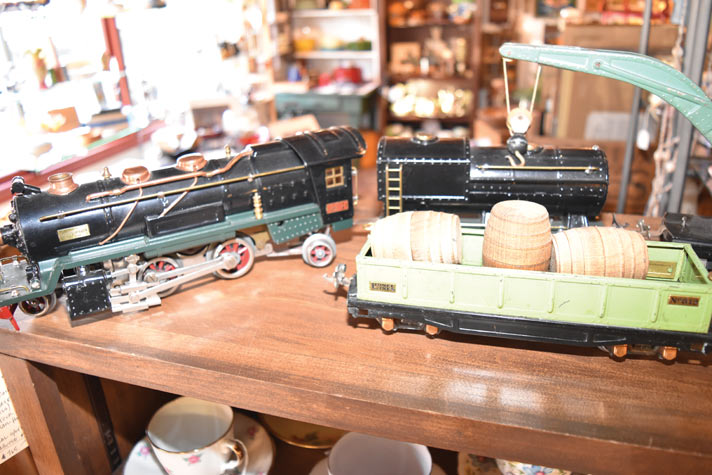Speaking of Antiquing – February 2019
From the dawning of the locomotive age came the love of toy trains that followed. Children and adults alike fantasized about traveling down a narrow track to distant places and to experience unknown adventures. Generations of travelers with volumes of stories, and the longing that a train whistle evoked, were made real on a playroom floor.
In the early 1890’s, a German toy maker, Marklin Brothers, was the first to offer its customers entire layouts that could be put together one piece at a time. They were also credited with standardizing the sectional track and scale (the ratio of real to model) and gauge (the distance between tracks).
In the US, electric trains were introduced in 1897 by Carlisle and Finch in Cincinnati, Ohio. Ives, American Flyer, Lionel, and Marx followed. The first half of the 20th century saw developments in lighting, directional change, whistle, smoke, and other operational features that enhanced the experience.
The Lionel Company was formed almost by accident. In 1900 Joshua Lionel Cohen designed a display of his wooden open-bed gondola with “Electric Express” on its side to display other items for a Manhattan toy store window. After a customer bought the whole thing right out of the window, orders for more forced Cohen and Grant, his associate, to begin The Lionel Company.
As was the case in many industries, involvement in two World Wars impacted resources, manufacturing, supply and demand. Standard gauge 2 1/2″ track width and model train scaled accordingly, were large. The depression pushed efforts into the smaller O gauge 1 1/4″ track width, and model train scaled accordingly. As the demand for metal went with the war effort, smaller trains were manufactured.
Lionel became the largest producer of model trains. At its peak in the 1950’s it grossed over $25 million each year. Lionel’s Santa Fe F3 line is a beautiful example of Americana, with its iconic vibrant red and yellow engine and “War Bonnet” nose. Being in production from 1948 to 1966 it was the biggest selling model train of all time. It’s probably the most easily recognized model train there is.
Collectors of model trains will want to collect specific train lines such as Pennsylvania Railroad, Union Pacific, Santa Fe, or Southern Pacific. They will collect by era, pre-war covering years 1900-1942; post-war 1945-1969. The companies they might collect include Ives, American Flyer, Lionel, Marx, Marklin, Hornby, or Kato. Perhaps it is the scale and gauge they desire, be it standard, O, HO, N, Z gauge, and not to mention the uniquely-scaled accessories.
Model trains are indeed a fascination to this day. The Lionel model trains in Pickety Place often arrest a browsing customer and stories of childhood memories are told. Model trains are not just for displaying under a Christmas tree anymore. The intricate detail of the models are truly works of art that should be displayed!

 Margaret Barns is co-owner of Pickety Place Antiques & Collectibles located at 130 N. 4th Street in Jacksonville. LIKE them on
Margaret Barns is co-owner of Pickety Place Antiques & Collectibles located at 130 N. 4th Street in Jacksonville. LIKE them on